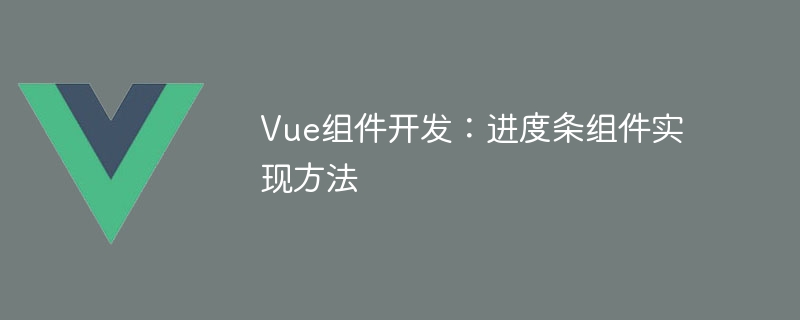Home >Web Front-end >Vue.js >Vue component development: implementation method of progress bar component
Vue component development: implementation method of progress bar component
- PHPzOriginal
- 2023-11-24 08:56:101235browse

Vue component development: Progress bar component implementation method
Foreword:
In Web development, the progress bar is a common UI component. , file upload, form submission and other scenarios are often used to display the progress of operations. In Vue.js, we can easily implement a progress bar component by customizing components. This article will introduce an implementation method and provide specific code examples. I hope it will be helpful to Vue.js beginners.
- Structure and style of the component
First, we need to define the basic structure and style of the progress bar component. In a Vue component, you can use the template tag to define the component's template. According to the needs of the progress bar, it generally includes an outer container and an inner progress bar.
<template>
<div class="progress-bar">
<div class="progress" :style="{width: progress + '%'}"></div>
</div>
</template>
<style>
.progress-bar {
width: 100%;
height: 20px;
background-color: #f1f1f1;
}
.progress {
height: 100%;
background-color: #42b983;
}
</style>- Component properties and data
In the Vue component, we can define the component's properties through the props attribute, and define the component's data through the data attribute. For the progress bar component, we need to define a progress attribute to represent the percentage of the current progress.
<script>
export default {
props: {
progress: {
type: Number,
default: 0
}
}
}
</script>- Use of components and passing values
When using the progress bar component in a Vue application, we need to pass in a progress attribute to specify the current progress value. This property can be dynamically bound via the v-bind directive.
<template>
<div>
<progress-bar :progress="progress"></progress-bar>
<button @click="start">开始</button>
<button @click="reset">重置</button>
</div>
</template>
<script>
import ProgressBar from './ProgressBar.vue'
export default {
components: {
ProgressBar
},
data() {
return {
progress: 0
}
},
methods: {
start() {
this.progress = 0;
this.timer = setInterval(() => {
this.progress += 10;
if (this.progress >= 100) {
clearInterval(this.timer);
}
}, 1000);
},
reset() {
this.progress = 0;
clearInterval(this.timer);
}
}
}
</script>- Example Demonstration
First, create a ProgressBar.vue file in the root directory of the Vue application and put the component's structure, style and attribute definitions into it.
Then, in the main component of the Vue application, introduce the progress bar component and define a progress attribute in the data attribute to represent the current progress. Through the click event of the button, we can change the progress value of the progress bar to achieve the dynamic effect of the progress bar.
Finally, render the main component to the root node of the Vue application, and run the application to see the progress bar effect.
Summary:
Through the above steps, we have introduced in detail how to use Vue.js to develop a progress bar component. By defining the structure and style of the component, and using property and data binding, we can easily implement a powerful progress bar component. I hope this article will be helpful to developers who are learning Vue.js.
The above is the detailed content of Vue component development: implementation method of progress bar component. For more information, please follow other related articles on the PHP Chinese website!
Related articles
See more- Implementation of HTML5+CSS3 loading progress bar and download progress bar
- How to use vuex? Detailed explanation of vuex usage steps (with code)
- 12 Vue high-frequency principle interview questions (with analysis)
- Why can't my layui progress bar be rendered?
- What is the difference between vue and uni-app

